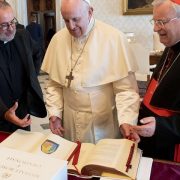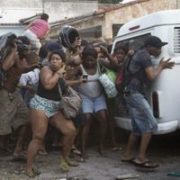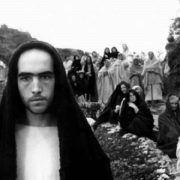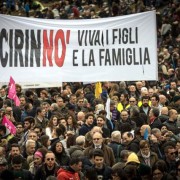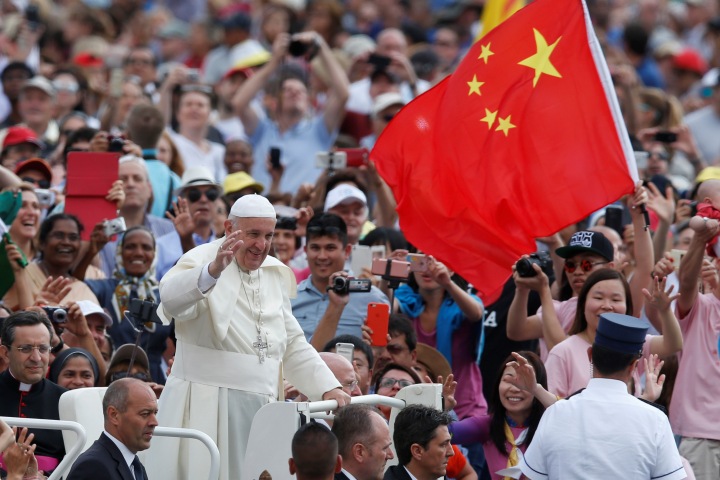
The meeting, the rapprochement, between the Holy See and China has a thousand faces, of course. There are the questions of faith, of religion, of souls approaching one another, of tension toward the afterlife, and communication with people on this side. All are important points, perhaps the most fundamental and profound. But seen from China, the question is essentially about power and politics. So, for the benefit of the meeting and approach, it is perhaps appropriate to understand the Chinese position. This has three acts, as in classic tragedies.
A comparison of empires
For China, the Holy See is first and foremost an empire that must be compared to what in fact is the Chinese empire. The beauty of China lies in its relative simplicity as an empire. Today it has about 1.4 billion people. About 95% of these are ethnic Chinese (so-called Han people) and speak fluently or understand Mandarin Chinese.
Since 1980, Beijing has harshly imposed the one-child policy, which has taken from its population in these forty years approximately 400 million new citizens. In coming days the one-child policy could be completely eliminated. This could relaunch births and therefore population growth, thus avoiding the trap of the progressive aging of the nation, which would also have an impact on economic development. In other words, China is the largest mass of the world’s population, which has grown economically by more than 8% a year over the last 40 years, figures that guarantee the doubling of GDP every eight years. This means that in 40 years the wealth of these 1.4 billion people has increased about 30 times, or 3,000%!
The only other political empire that can be compared in terms of numbers is India. The total number of the Indian population may soon exceed the Chinese. Furthermore, the Indian population, which has not undergone decades of forced family planning, is younger. But compared to China, India is very divided internally.
In India there are great linguistic divisions between north and south. The north is Indo-European, the south Dravidian. There are divisions of caste that deeply segment Indian society. There is hatred between Muslims and Hindus, and even among Hindus there are different rituals and perhaps completely different religions: one believes that the supreme deity is Brahma, another Vishnu, another Shiva, and others prefer completely different gods. In addition among the Indo-Europeans and Dravidians there are strong, separate identities: the Bengalis feel different from the other inhabitants of the north, and they are even separated into two different states one within the Indian union, the Hindu, and the Muslim outside of it in Bangladesh. Moreover, India’s growth has not been so overwhelming, even if it is accelerating now.
In China, these divisions are not there. There are ancient regional separations. People recognize themselves deeply in the province they belong to. But the predominant feeling is to be proudly Chinese first and then of Beijing, Shanghai, or Canton.
With this kind of mental habit, the Chinese have difficulty taking the measure of the Holy See. What is the Vatican? Seen in its essence, it is a half square kilometer set in the center of the capital of Italy, with a few thousand citizens who come and go freely from its national borders. At first glance it seems simply a geopolitical curiosity, like San Marino or Andorra.
But there is another dimension of the church: it is the largest unitary religious entity in the world. The church claims to have 1.3 billion baptized members. Its number is increasing rapidly, especially in Africa, the continent with the world’s largest population growth. Furthermore, hundreds of millions of Orthodox Christians and Protestant Christians, even if they are outside the unity of the Catholic Church, have great respect for the church and for its Pope.
Respect and admiration for the church and Pope is also found increasingly among the billion Muslims around the world. This is due to historical reasons: beyond the religious wars of the past, Islam recognizes Christianity as its antecedent. Moreover, in more recent times, when Islam has been attacked from within by fundamentalists and outside by “warriors of civilizations” wanting a new religious culture clash, the Pope and the church have always spoken in favor of dialogue and understanding. And they were the only ones to act and move on behalf of refugees (who are often Muslims) driven out of warzones. This increased the prestige of the church and of the Pope among all Muslims, who are mostly normal people who only want a peaceful life today and tomorrow.
It is therefore a kind of light, soft empire, in concentric circles, with direct influence and ever more indirect but still real influence over about half of the planet’s population, almost 4 billion people. Moreover, this Pope has repeatedly stressed that he is not simply interested in “his” people. He speaks all over the world, even to the 3 billion Chinese and Indians who are not Christians or Muslims and to the many animists around the world.
However, what kind of authority does the Pope have over this mass of people? In China it is clear that President Xi Jinping, or his predecessors and successors, has the ultimate power of life or death over all his subjects. The official who does not obey him can be sent to prison, fired, or even executed. On the other hand, the Pope, as is clear from the chain of scandals and true or false revelations that continues to shake the Holy See, does not exercise or have, or does not want to have, the power to dismiss his collaborators who lack the most basic security or confidentiality rules.
So it is a power without power, simplistically seen from Beijing. A power that is almost useless.
Yet it is not like that.
All the controversy widely followed by the world press on the shortcomings of the Pope or his curia and the thorny controversies over the normalization of relations between the Holy See and China demonstrate the extraordinary and peculiar power of the Pope and his church. It is a power that for some is even higher than the power of the Chinese president. In fact, in 2015 when the state visits to America of the Chinese president and the Pope coincided, politicians and the American public gave much more importance to the Pope than the president. This was a kind of culture shock for China.
In this short-circuiting of power by the Holy See, there is also all the drama and confusion China feels in confronting the Vatican. If the Holy See is not a real power, it does not count, it’s useless, and so it’s not worth talking to. If it is a real power that counts, it is an immense power, and therefore it must be approached with extreme caution because it can blow in your face. In past decades, the predominant attitude in Beijing was the former, but in the last few years it began to be the later. This means that in Beijing people believe: we must talk to the Holy See, but we must also be extremely careful, in the event that future changes of opinion in Rome also directly affect Chinese domestic politics.
A comparison of powers
There is a second short circuit in the comparison of power. Chinese power, which by imperial tradition is absolute within its territory, must find a way to live with the power of the church. The problem is very deep and touches on identity issues of the Chinese state. The first unified empire gave an almost divine authority to the emperor. The emperor, however, had as his predecessor the sovereigns of the various separate Chinese states.
The ideogram that described him, wang, has three horizontal parallel lines unified in the middle by a vertical line. It described the entity that unifies the three worlds: the sky, human society, and nature. Since ancient times, it was therefore a power that unified religious and political aspects in the same person, perhaps in a manner similar to that of the Egyptian pharaoh, but in a very different way from the Greek polis or the Roman republic, which provide the basis for the Western conception of a state.
Without going into ancient and complicated questions, it is sufficient to think that for thousands of years in the West, a dichotomy was recognized between the religious power of the church and the political power of the state. This dichotomy did not exist in China. On the other hand, in China there was not a real state religion as Islam was in Muslim countries under the caliph. The Chinese for centuries were free to practice and follow whatever religion they preferred.
But the principle was that final total authority over any religion within China belonged to the emperor. This principle was fundamental to the dispute over the rites that separated the Jesuits from Franciscans and Dominicans in the 16th and 17th centuries. The Jesuit bet was to resolve the contradiction by converting the emperor and then converting all of China. In other words, it was a neo-Constantinian bet, to do with the emperor and the Chinese empire what Christians in the fourth century had done with Constantine and the Roman Empire. The bet failed because the Jesuits gave in to two opposing and contrary thrusts.
The emperor did not convert because Christianity had not adapted sufficiently to the Chinese reality, and the church, on the other hand, feared corrupting itself too much in this adaptation and thereby detaching itself completely from its roots. Today, in some ways, the situation is very different, but there are also points of profound coincidence with the past. The fundamental difference is that today the Chinese president no longer claims to have any religious authority. The dominant ideology in the country is a Marxist one that is explicitly atheistic, and therefore not religious. Therefore the government has no authority over the choice of religion. The church, for its part, with the end also of the Papal State, has ceased all claims of political power, so the “zones of authority” of Chinese government and Holy See do not touch each other: one is political-civil, the other spiritual-religious.
This creates a theoretical space in which China and the Vatican can live together. In practice, however, there is a huge gray area where the two powers touch and meet. For example, there is a fundamental question for the church over the choice of bishops. They are the religious meeting point between the local community and the Pope. But in fact the bishops are also a point of strong social influence, and therefore in fact they do exercise some sort of authority in the Chinese territory. This problem for the church is thorny but ancient. It is the question of investiture that tormented the relationship between the Pope and the emperor of the Holy Roman Empire in the Middle Ages.
In the 1980s and 1990s, when the church was looking for a new relationship with China, this issue had been addressed and managed by the Chinese Catholic Patriotic Association to which “the emperor” had granted special powers of autonomy in relations with “the stranger” (the Vatican in this case). Similarly, in imperial periods, the imperial supreme authority maintained its overall power but granted political-religious-cultural enclaves to various entities. These concessions in this case, however, created profound confusion, as was clear at the beginning of the 2000s. All the bishops appointed by Beijing had asked the Pope for forgiveness, hidden from the authorities of Beijing itself. From a purely power point of view, then, Beijing thought it had half of its “bishops” and half were the Pope’s bishops, and Beijing could deal with the Pope on the basis of this division. In reality, Beijing found out that the Pope had all the bishops, and therefore it had nothing to bargain with. This started a profound rethinking of the whole Vatican question by China.
The realization that the problem of unity between bishops and the Pope was insurmountable, and the fact that the Communist party was atheistic, gradually led to the principle of admitting the Pope’s religious authority in China.
Here the question of China touches on another short circuit of the power of the Pope and of the church. If the power of the Pope over the bishops, and with the church, is weak, as we saw in the first part, then why does the Pope insist so much and in such detail on the choice of bishops? If the power of the Pope and the church over the bishops is strong, why can’t the Pope restore order and impose his dialogue with China on the many Catholic fringes that are active every day with anti-Chinese polemics?
Naturally, China does not ask these questions directly, and these questions are objectively very difficult to find answers to from the church because they do not fall within a “political-political order”, but they are invested with particular religious aspects, which are esoteric in a world like China that is unrelated to the Christian tradition. In the absence of complete and understandable answers from the Holy See on this, Beijing asks for more administrative guarantees over its territory for the life of the church. But this creates problems and lacerations for the church in which the Chinese question is important, but it is also only part of a much wider problem of attention.
Political politics and an international Luther of today?[1]
Here, from the short circuits between politics and religion, we move on to questions that are really mainly political. While in the past the talks between China and the Holy See took place in a peaceful international atmosphere around China and inside the Holy See, both aspects have changed in recent years.
There is growing international tension with China. Parts of the Western world fear that a normalization of relations between the Holy See and China will hinder a tough confrontation that some countries want, or may wish for, with Beijing. Furthermore, while the church was substantially united in past decades, today moral issues are tearing the church apart. These questions focus on problems of morality that appear antiquated and incomprehensible to the majority of modern society. The admission to communion of people who are divorced and greater tolerance for homosexuals are openings that are deeply reflected in modern society. But they are also issues that split or risk splitting practices and perceptions of ancient church orthodoxy.
On the other hand, the Chinese question is exactly the opposite as the moral questions.
The religious and political importance in the Chinese affair is subtle, delicate, and in fact incomprehensible to the majority of the public that sees China increasingly as a totalitarian communist monster, a comic-book definition that however is well suited to the situation between China and the rest of the world in this moment. But it is important and fundamental for a thin group of Catholics who see the future prospects as fundamental for the place the Church will have in the world in the next decades or centuries. In this situation, therefore, it can be easy for some opponents to use the position of the Pope on China (incomprehensible for the masses) to show also his failure and his errors in moral matters (also understandable for the masses).
In this, the whole Chinese and moral affair goes beyond religious matters. In 1517, when Luther posted his famous theses against Rome, he probably could have been reabsorbed and sanctified, as happened three centuries before with St. Francis. Or he could have simply been crushed and marginalized as were the Waldensians, almost contemporaries of Francis of Assisi. That Luther became the father of the Protestant reform, midwife of the great political and cultural rift between northern and southern Europe, is due to a purely political problem. The German princes wanted to obtain autonomy and independence from the Habsburg emperor. Luther provided them with a flag and an ideology. That is, without the political ambitions of the German princes the church would not have split. Today the problem of the church, in other words, is perhaps not religious (discussing with China how and when to appoint bishops) but political: how to hold together a church where many faithful Catholics are hostile to Beijing in this general atmosphere of confrontation between the West and China.
Here again we return to a question for Beijing. If the church remains united and manages to maintain a relationship with the American conservatives—those who want war with Beijing and do not want the Pope’s moral reforms—then the church has a value for China, which wants to avoid this war with the West. If, on the other hand, the church breaks on China with American conservatives, the value for Beijing of the church would diminish. That is, China should continue to try to talk with American conservatives without the good offices of the church. The church must avoid entering into a situation in which the more it speaks to Beijing the more it moves away from America.
In other words, the religious question of the new morality and the new approach with China can perhaps be solved only in political terms. If the church manages to be a political bridge between China and the rest of the world, it not only solves many of its internal issues but creates an immense future space for its role in the coming millennia. If it fails in this high political mediation, vice versa the church risks shattering or decreasing in importance exponentially. The risk for the church is therefore a thousand times, a million times that of the scandals over sexual abuse by priests. The returns on the good management of this affair could be equally enormous. Of course, this is politics, which only marginally interests the church, which lives and can live on something else. But it is a real, current space with which perhaps one must reckon.
[1] See Giancarlo Pani, Paolo, Agostino, Lutero: alle origini del mondo moderno, Rubettino, Soveria Mannelli 2005.


